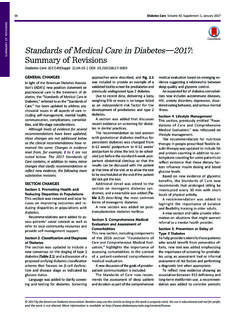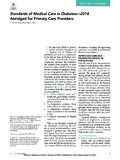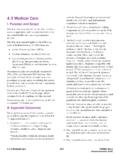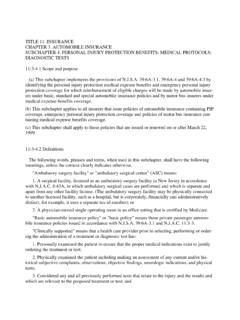Transcription of MEDICAL PROVIDERS’ GUIDE TO MANAGING THE …
1 MEDICAL PROVIDERS GUIDETO MANAGING THE care OF DOMESTIC VIOLENCE PATIENTS WITHIN A CULTURAL CONTEXTM ichael R. BloombergMayorCity of New York Message from the New York City Mayor's Office to Combat Domestic Violence Domestic violence is pervasive, with 1 in 4 women experiencing abuse during their lifetimes. In 2002, the World Health Organization identified domestic violence as a serious public health problem with victims experiencing more operative procedures, visits to doctors and hospital stays than non-victims. Domestic violence causes not only acute injuries, but also has been linked to serious health consequences such as chronic pain, abdominal complaints, sexually transmitted infections, unwanted pregnancies, depression, post-traumatic stress disorder, miscarriages and premature labor. Unfortunately, many victims suffer in silence and are not receiving assistance for their abusive situation.
2 Analysis of family violence-related homicides in New York City reveals that 71% of the cases in 2003 had no prior police contact and 87% had no current order of protection. Healthcare professionals play a crucial role in identifying victims because they have a regular opportunity to ask patients about domestic violence, regardless of the reason for the MEDICAL visit. By routinely screening patients for domestic violence, healthcare professionals can assist victims who may not seek assistance elsewhere. By directly asking patients about domestic violence, regardless of symptoms, injuries or reason for the visit, there is an increased likelihood that victims will disclose abuse. Given MEDICAL practitioners specific roles and time constraints, responding to domestic violence can be challenging. This manual explores methods of overcoming these challenges and intends to assist practitioners to efficiently identify domestic violence victims, intervene effectively, and provide meaningful referrals.
3 It is key that each domestic violence case is approached systemically while having each professional limit his/her role by area of expertise. The manual also focuses on methods of communicating effectively with patients from diverse cultures and practical suggestions are discussed. This manual is distinctive because it was developed with input from survivors and current victims of domestic violence representing diverse communities as well as healthcare professionals from a variety of clinical settings. Experts from various fields who work with domestic violence victims also contributed significantly to this initiative. The New York City Mayor's Office to Combat Domestic Violence is pleased to present the second edition of MEDICAL Providers GUIDE to MANAGING the care of Domestic Violence Patients Within a Cultural Context, developed in collaboration with the Department of Health and Mental Hygiene and funded by the Department of Health and Human Services.
4 This second edition contains additional scenarios and an expanded list of domestic violence resources. Sincerely, Yolanda B. Jimenez Commissioner Mayor s Office to Combat Domestic Violence July 20042 Acknowledgements Yolanda B. Jimenez, Commissioner Thomas R. Frieden, Commissioner Mayor s Office to Combat Domestic Violence Department of Health and Mental Hygiene Senior Authors and Editors Tracy Weber, Leanne Katz Levin Director of Grants and Interagency Coordinator Clinical Psychologist Mayor s Office to Combat Domestic Violence Graduate in MEDICAL Physiology Collaborators Amy Barasch, Esq., Mayor s Office to Combat Domestic Violence Julie Dinnerstein, Esq.
5 , Sanctuary for Families, Center for Battered Women s Legal Services Consuelo U. Dungca, , , New York City Health and Hospitals Corporation Ruth Forero, , Crime Victims Treatment Center, St. Luke s Roosevelt Hospital Susan Gambler, New York City Department of Health and Mental Hygiene Edmund Giegerich, , FACP, Long Island College Hospital Monique Vinet Imbert, Esq., Deputy Commissioner, Mayor s Office to Combat Domestic Violence Jennifer H. Lee, Esq., Sanctuary for Families, Center for Battered Women s Legal Services Dorchen Leidholdt, Esq., Sanctuary for Families, Center for Battered Women s Legal Services Amairis Pena-Chavez, , Sanctuary for Families, Center for Battered Women s Legal Services Liz Roberts, , Administration for Children s Services Susan Wilt, , New York City Department of Health and Mental Hygiene Sujata Warrier, , New York State Office for the Prevention of Domestic Violence Susan Xenarios, , Crime Victims Treatment Center, St.
6 Luke s Roosevelt Hospital Mary J. Zachary, , , Albert Einstein College of Medicine Contributors African Services Committee Arab American Family Support Center Bronx-Lebanon Hospital Center Church Avenue Merchants Block Association (CAMBA) Dwa Fanm Harlem Legal Services Long Island College Hospital New York City Health and Hospitals Corporation: Coney Island Hospital and Kings County Hospital Center New York Asian Women s Center Neighborhood Youth and Family Services 3 What You Will Learn Special Note Most domestic violence victims are women, and most abusers are their current or previous male partners. While aspects of this manual are applicable to the prevention, detection and intervention strategies for all domestic violence situations, the focus remains on screening female patients. In this manual, the victim is often referred to as female and the abuser as male.
7 Please note that domestic abuse also occurs in gay and lesbian relationships, teenage dating relationships, and among elders. In a minority of cases, the female partner abuses the male. No person deserves to be abused and every victim is entitled to effective treatment. U How to manage the screening process in a time efficient manner U How to manage the care of a patient who discloses domestic violence U The relevance of regular screening for all women U Available benefits for documented and undocumented immigrants U How to optimize the doctor-patient relationship in the context of cultural diversity U How to screen a patient when the abuser accompanies her to the appointment U Challenges that prevent women from disclosing abuse U How to place theoretical concepts in a practical context U The danger of using the abuser, family member.
8 Friend or another patient as an interpreter U How to implement guidelines for a domestic violence program in your facility U The importance of documentation for a complete diagnosis U The importance of a multi-disciplinary team approach 4 TABLE OF CONTENTS Section I: Optimizing Communication and Screening with Patients from Different Cultures 7 The Relevance of Screening for Domestic Violence 9 The context of domestic violence 9 Domestic violence is widespread 9 Failure to identify domestic violence may have serious consequences 10 Victims are unlikely to voluntarily disclose their abuse 10 Opportunity for the healthcare provider to intervene 10 Relevance of screening for domestic violence 11 Prevalence of domestic violence during pregnancy 11 Domestic violence risk factors can be identified in pregnant women 11 Domestic violence is an obstetric risk factor 12 Association
9 Between maternal illness and abuse 12 Summary 12 The Impact of Culture on the Doctor-Patient Relationship 13 Relevance of culture 14 A model for communicating effectively with the patient 14 Relationship factors 14 Skills 17 Summary 19 Techniques to Overcome Barriers that Healthcare Providers May Encounter 20 Concerns of healthcare practitioners and techniques to overcome them 21 How to approach screening 22 Look beyond the appearance of your patients and their partners 23 Summary 23 5 Challenges Preventing Immigrant Women from Disclosing Domestic Violence 24 An environment that is not conducive to disclosure 25 Fear for personal safety and pressure from the victim s support system 27 Fear of legal authorities 28 Factors complicating the diagnosis of domestic violence 31 Summary 32 Section II: Implementation of a Domestic Violence Screening and Service Program at Your Facility 33 Elements of Successful Implementation of Domestic Violence Programs 35 Five Stages of Successfully Implementing a Domestic Violence Program 36 Implementation: Policies and Procedures 37 Sample Treatment Flowchart 40 2003 Public Benefits for All Immigrants 41 Section III.
10 Assessment Tools, Safety Plan, Resource List, Types of Abuse, Power and Control over Immigrant Women and Victim Empowerment Wheel 43 Sample Screening Tool 45 Danger Assessment Instrument 46 Safety Plan 47 Resource List for Victims of Domestic Violence 48 Types of Power and Control 54 Power and Control over Immigrant Women Wheel 55 Victim Empowerment Wheel 56 Section IV: Learning in Action 57 Part One: Practical Exercises Regarding the care of Victims from Diverse Cultures 59 Part Two: Exploration of Culture 71 References 75 6 7 Section I: Optimizing Communication and Screening with Patients from Different Cultures 8 9 The Relevance of Screening for Domestic Violence The Context of Domestic Violence Domestic violence refers to abuse between members of a nuclear family or intimate It involves the repeated use of coercive and controlling behavior to limit and direct the victim s thoughts, emotions and behavior.

















